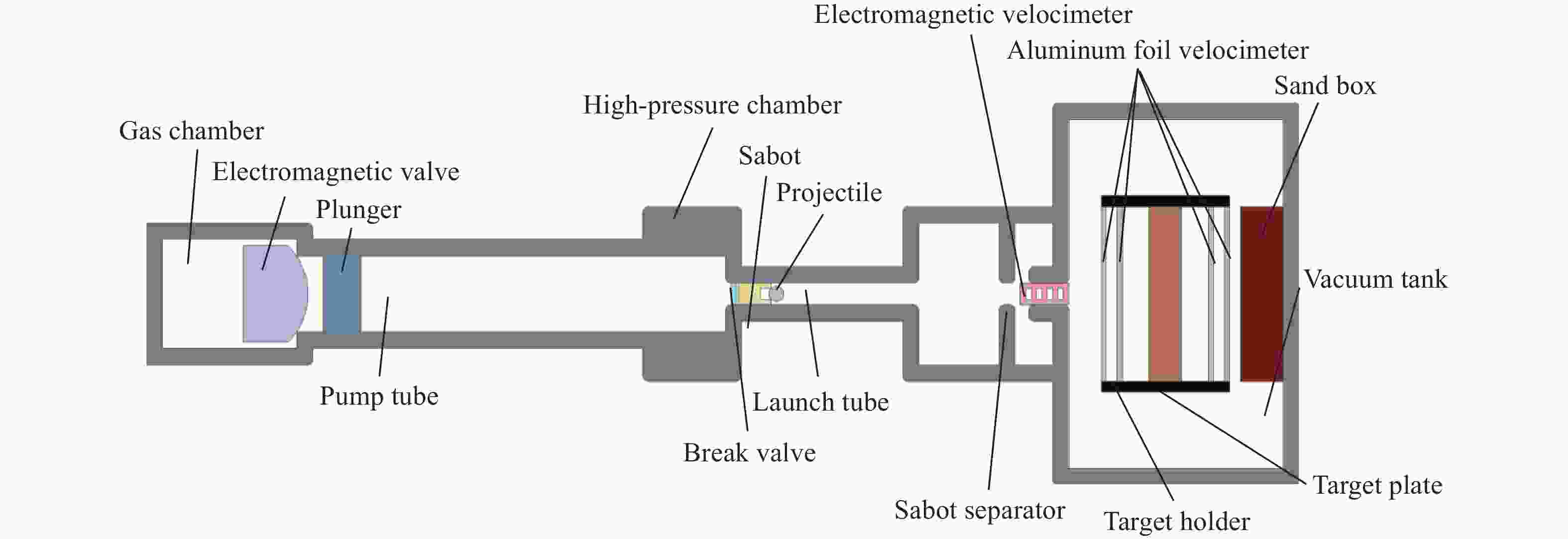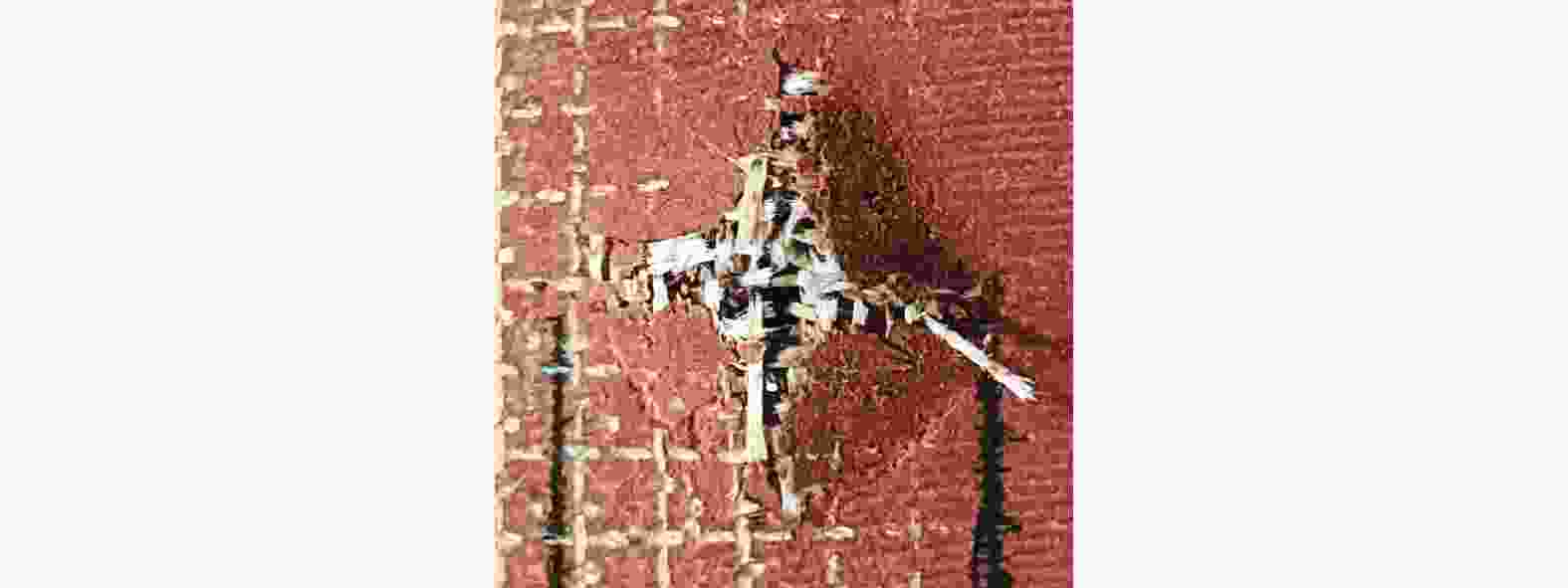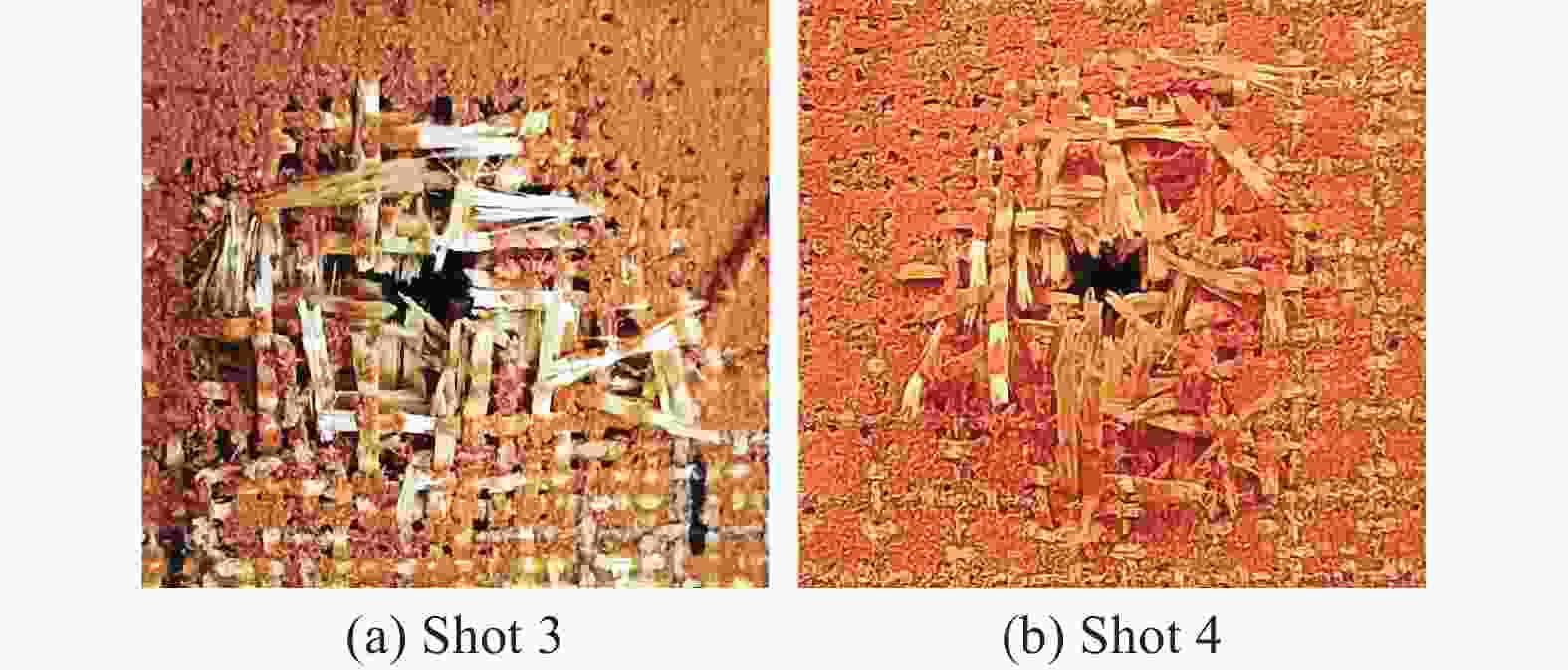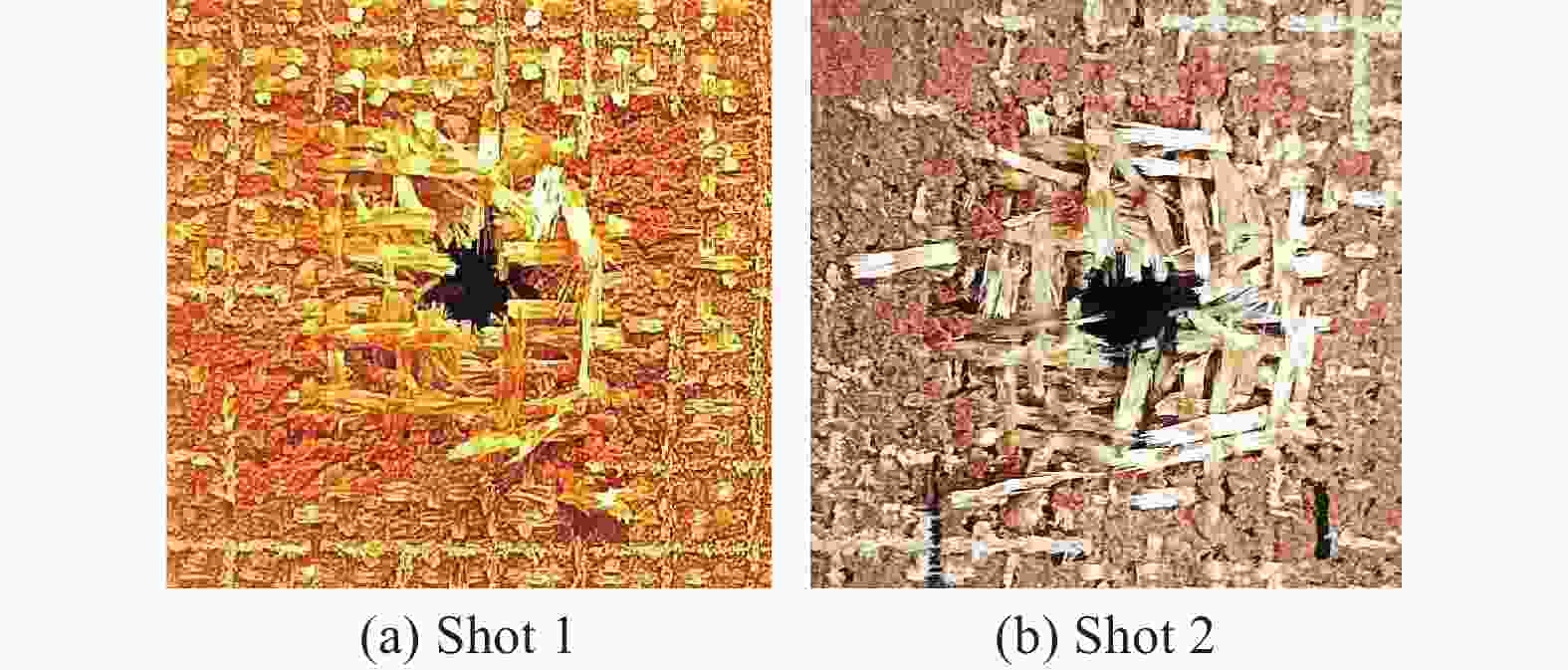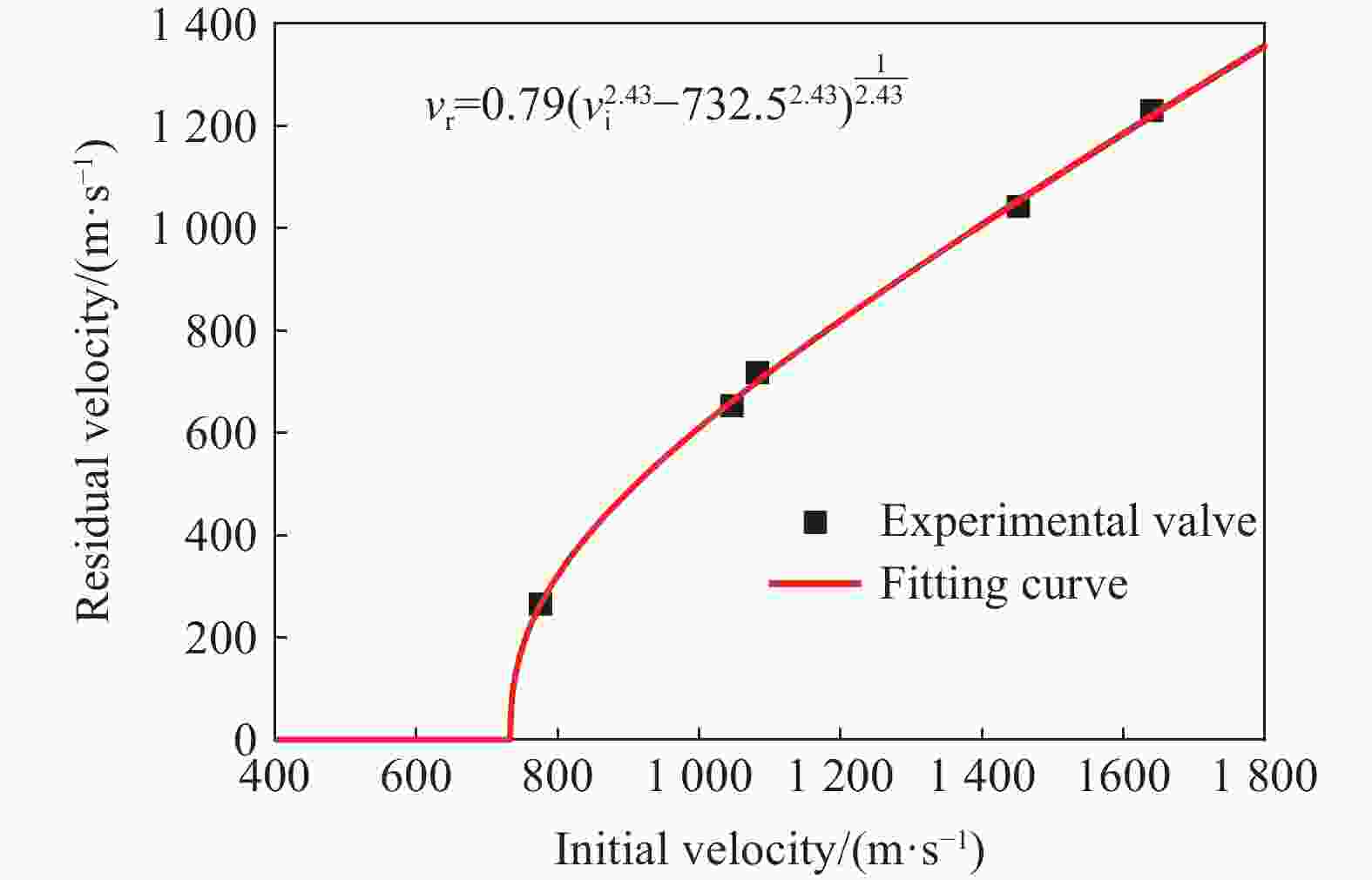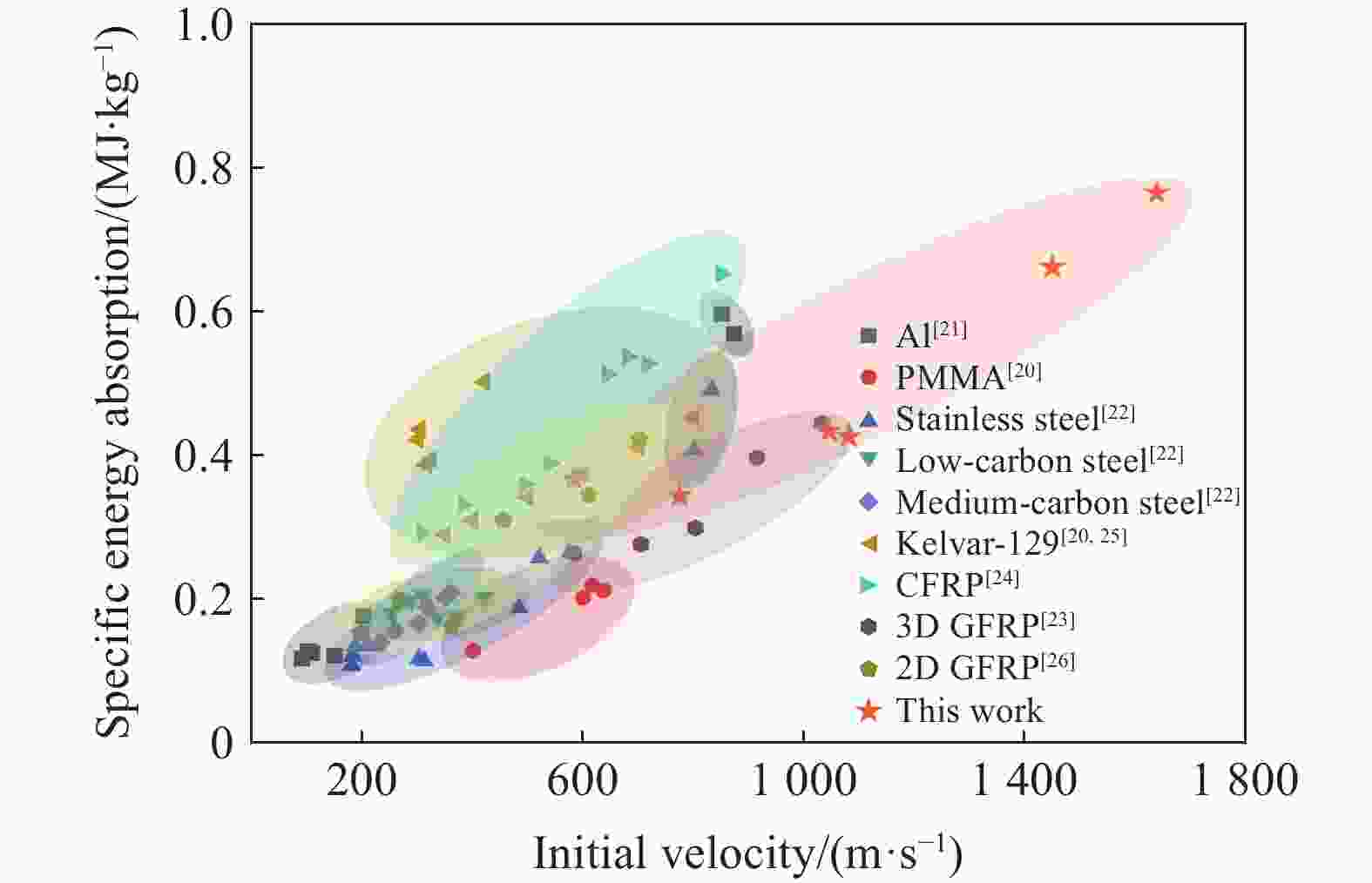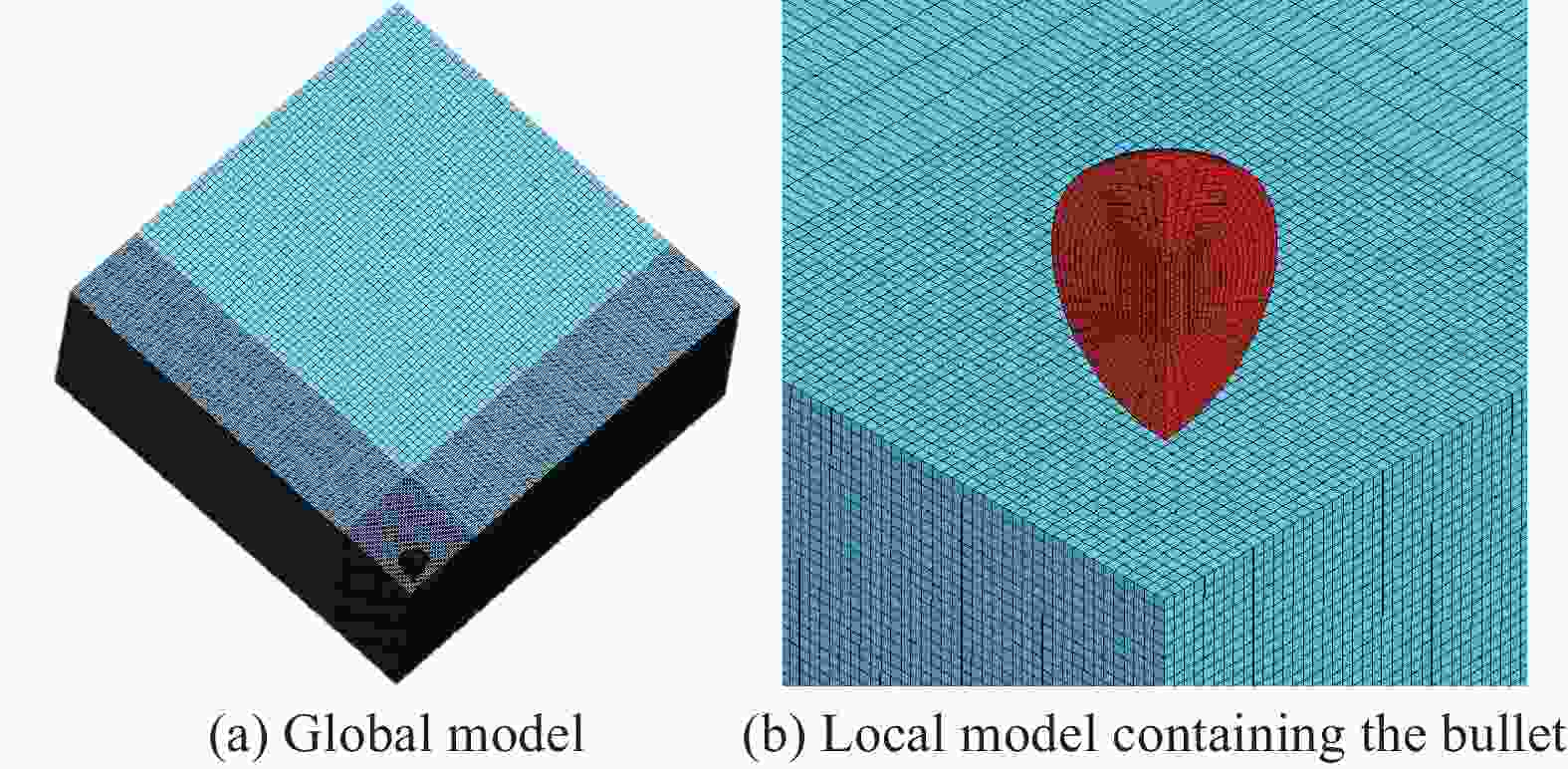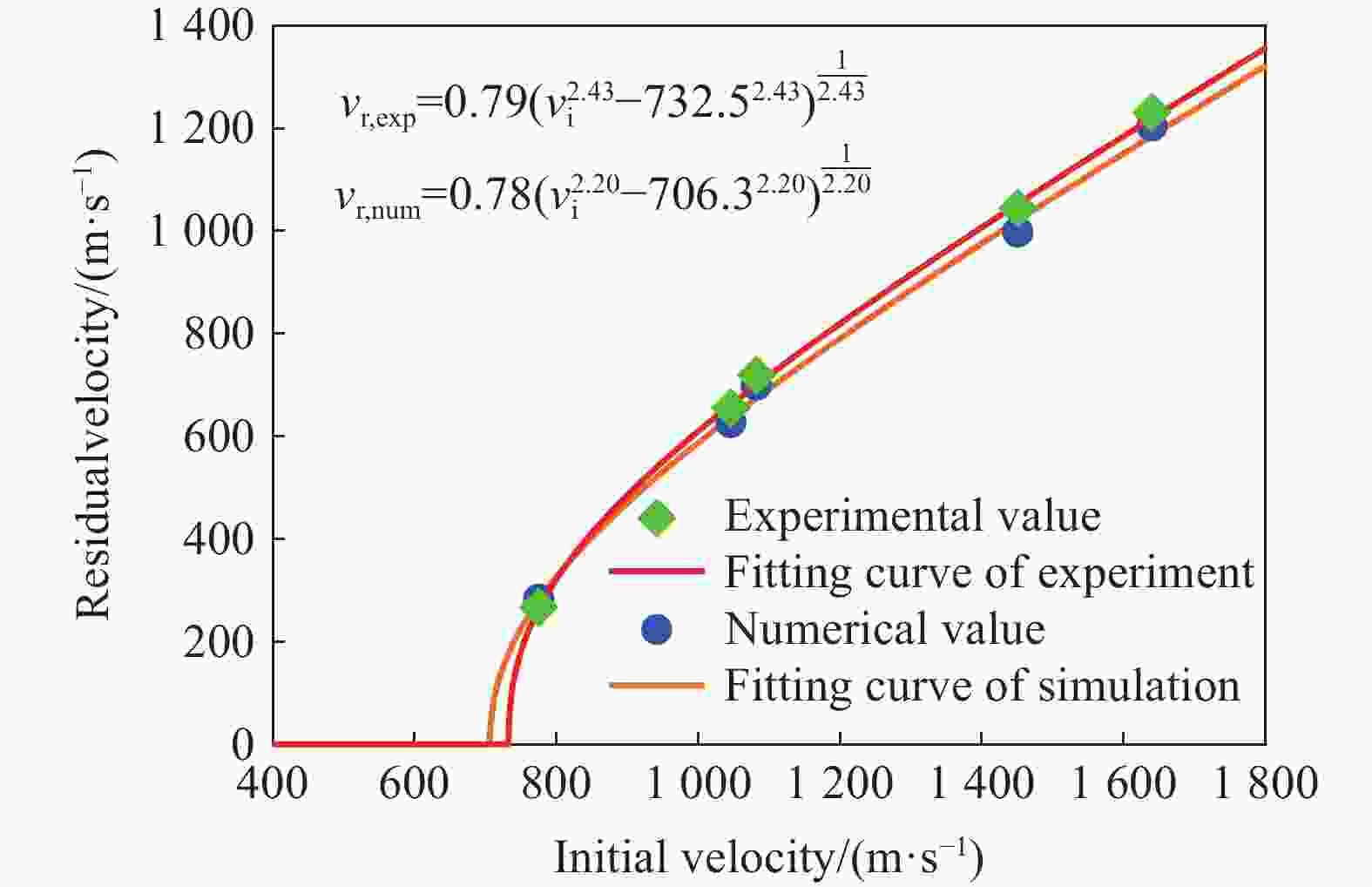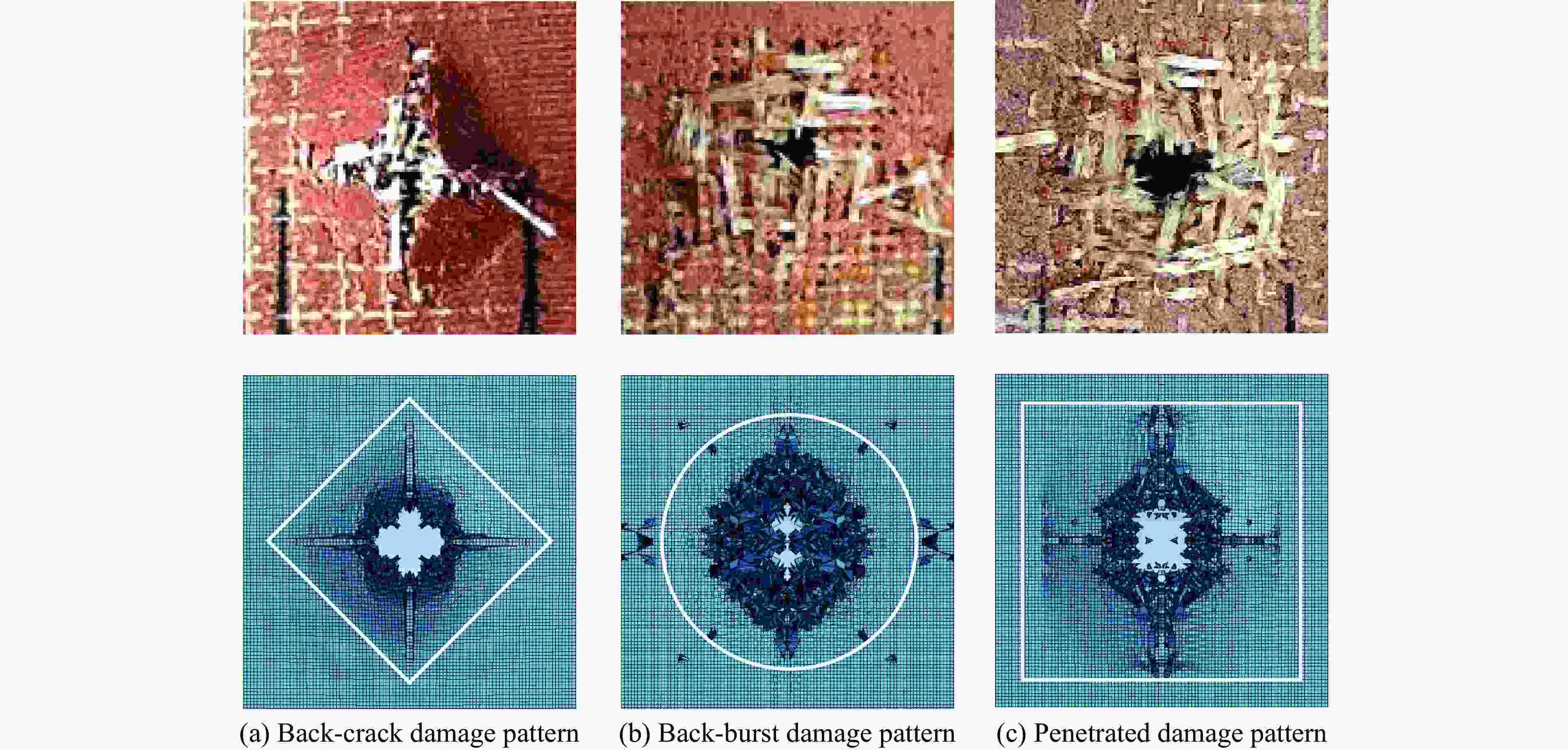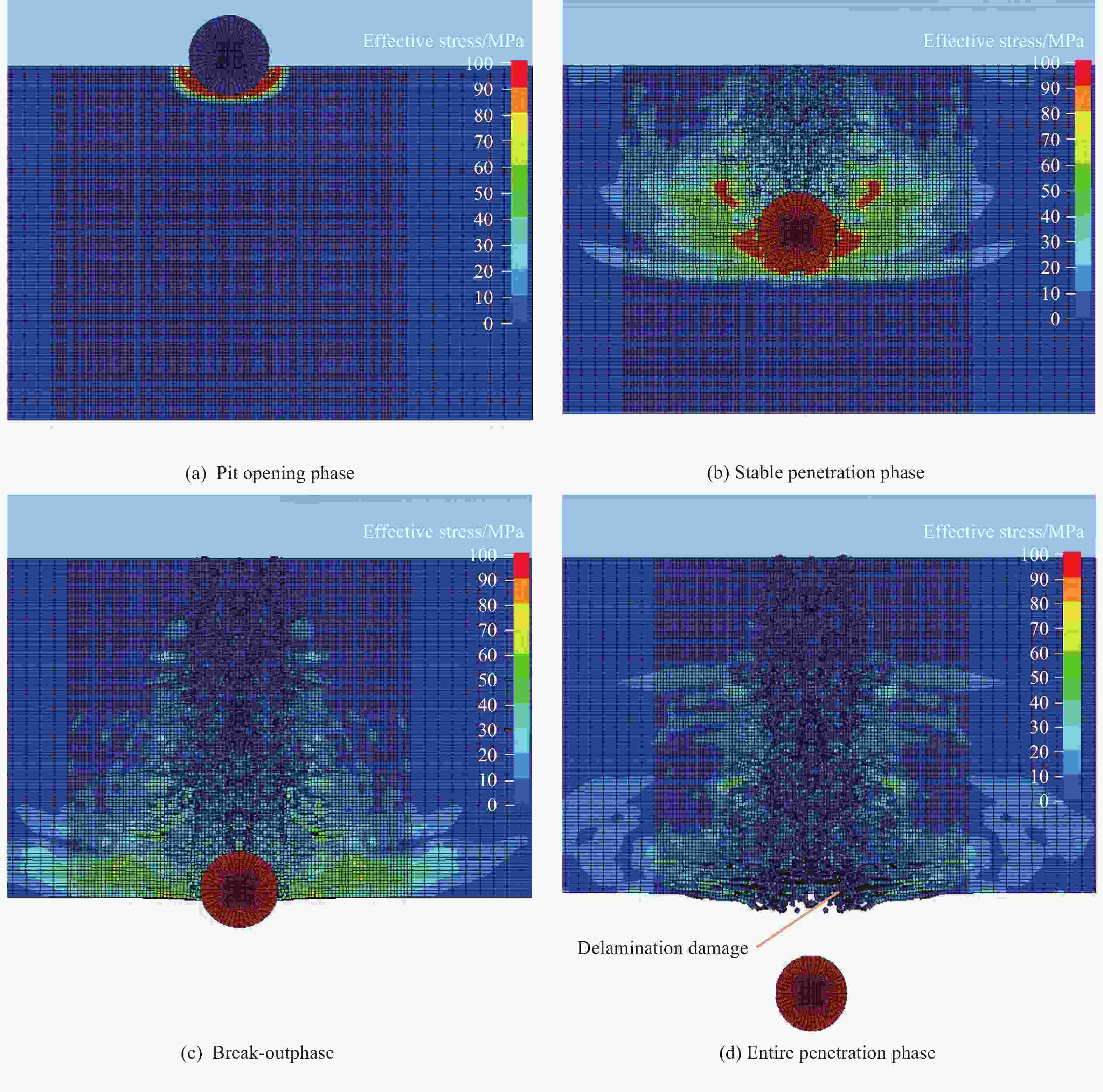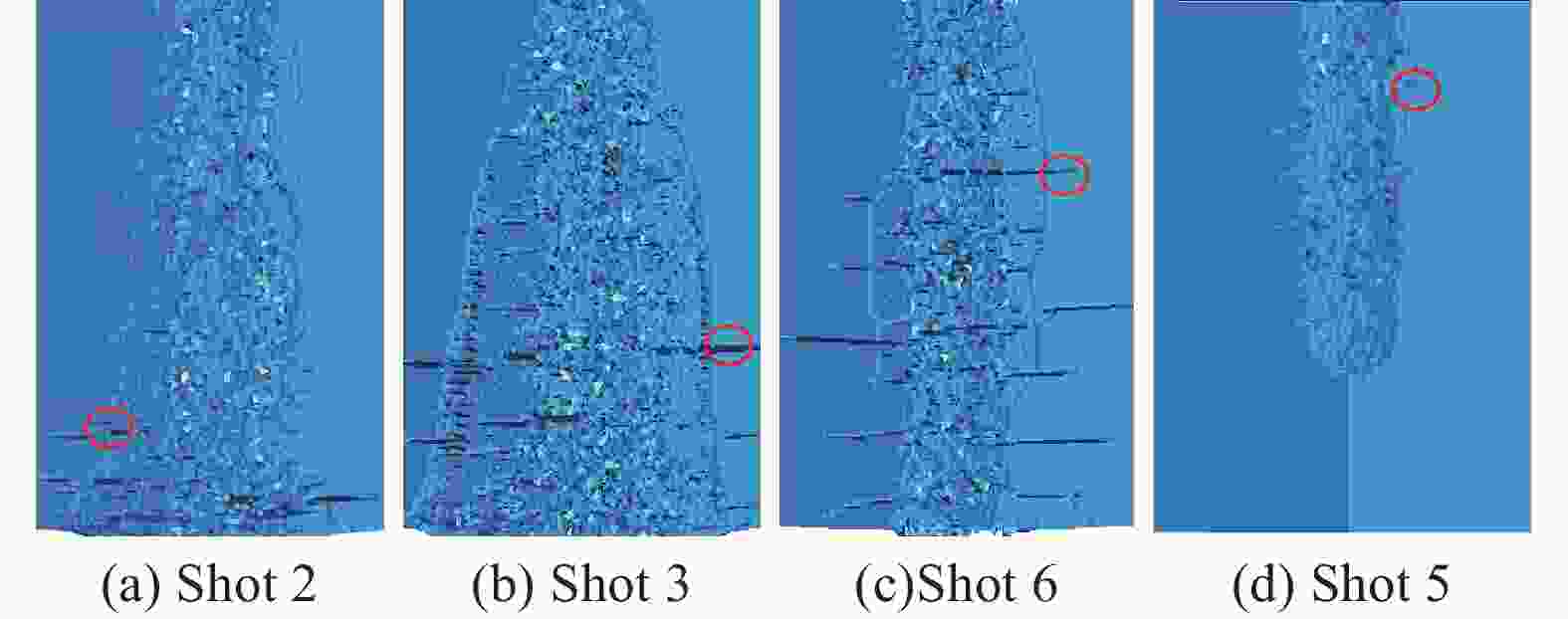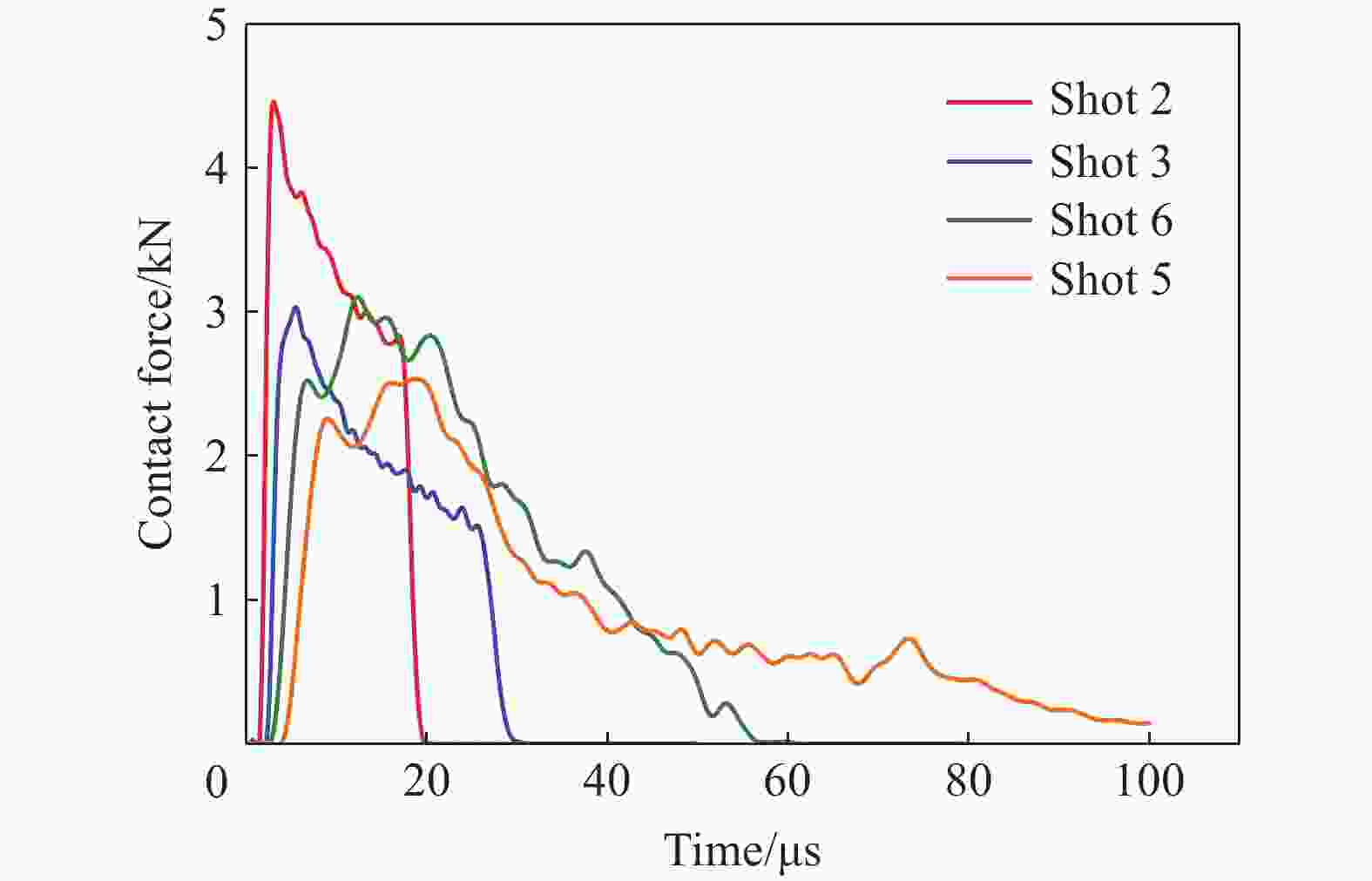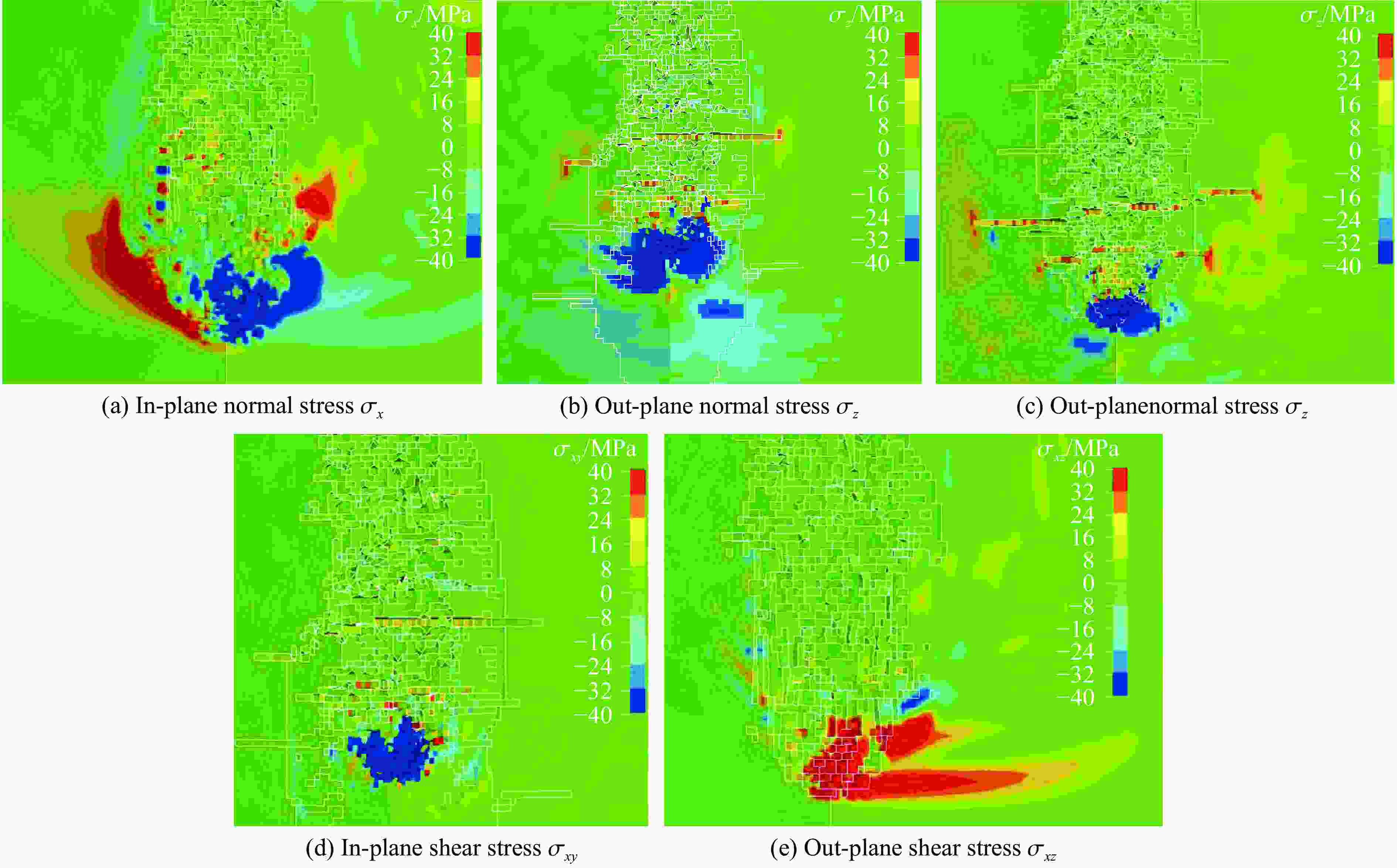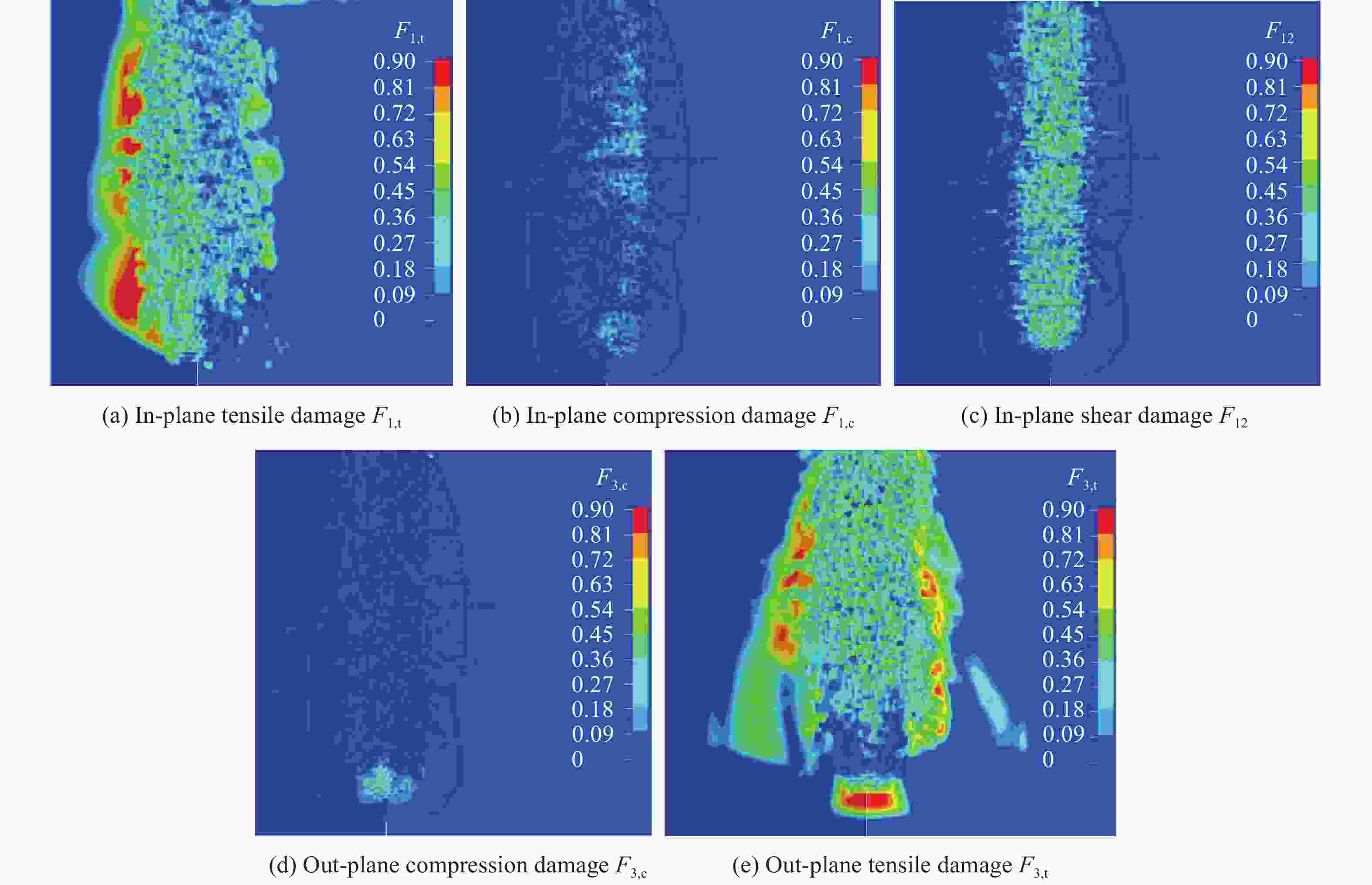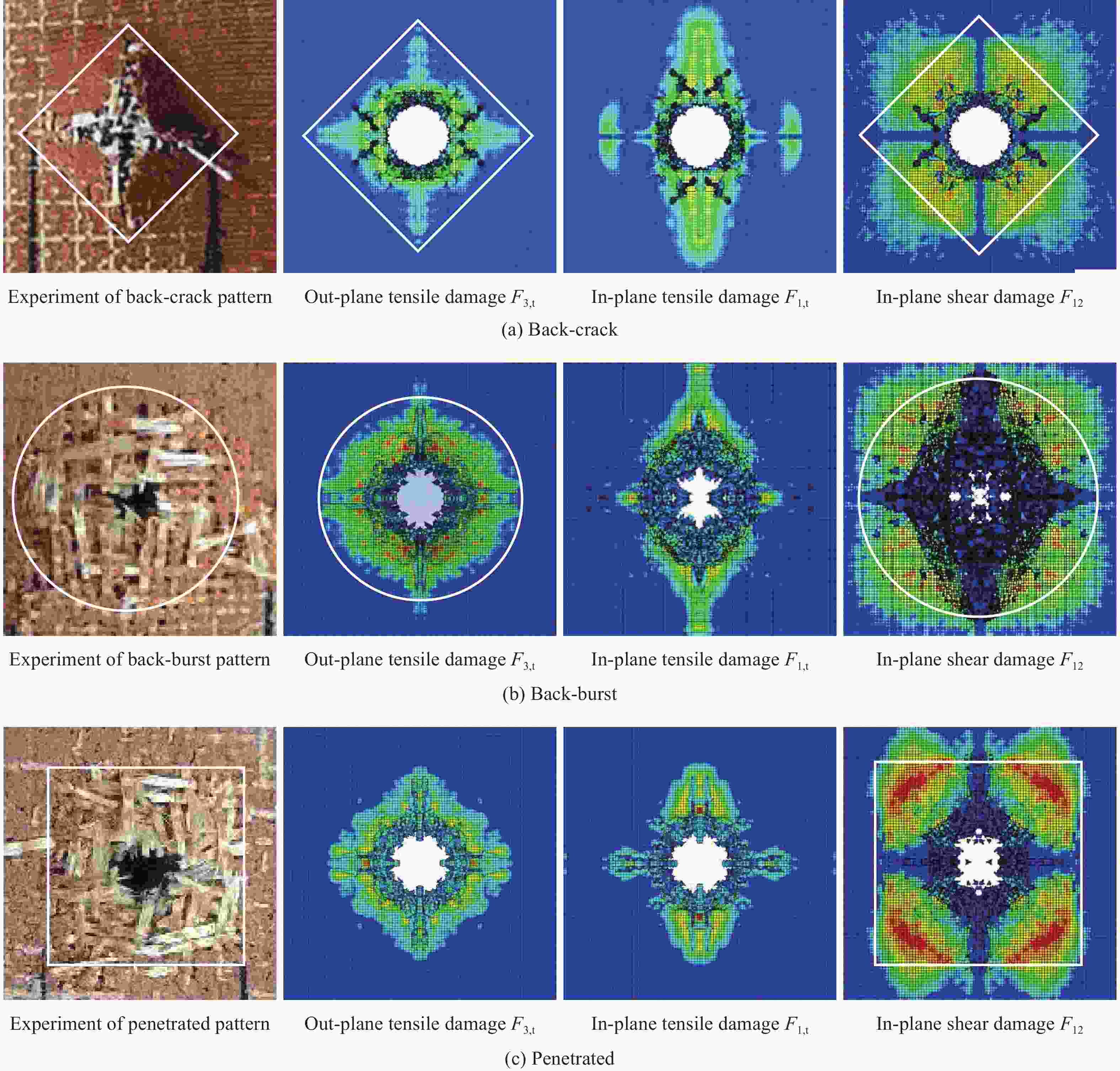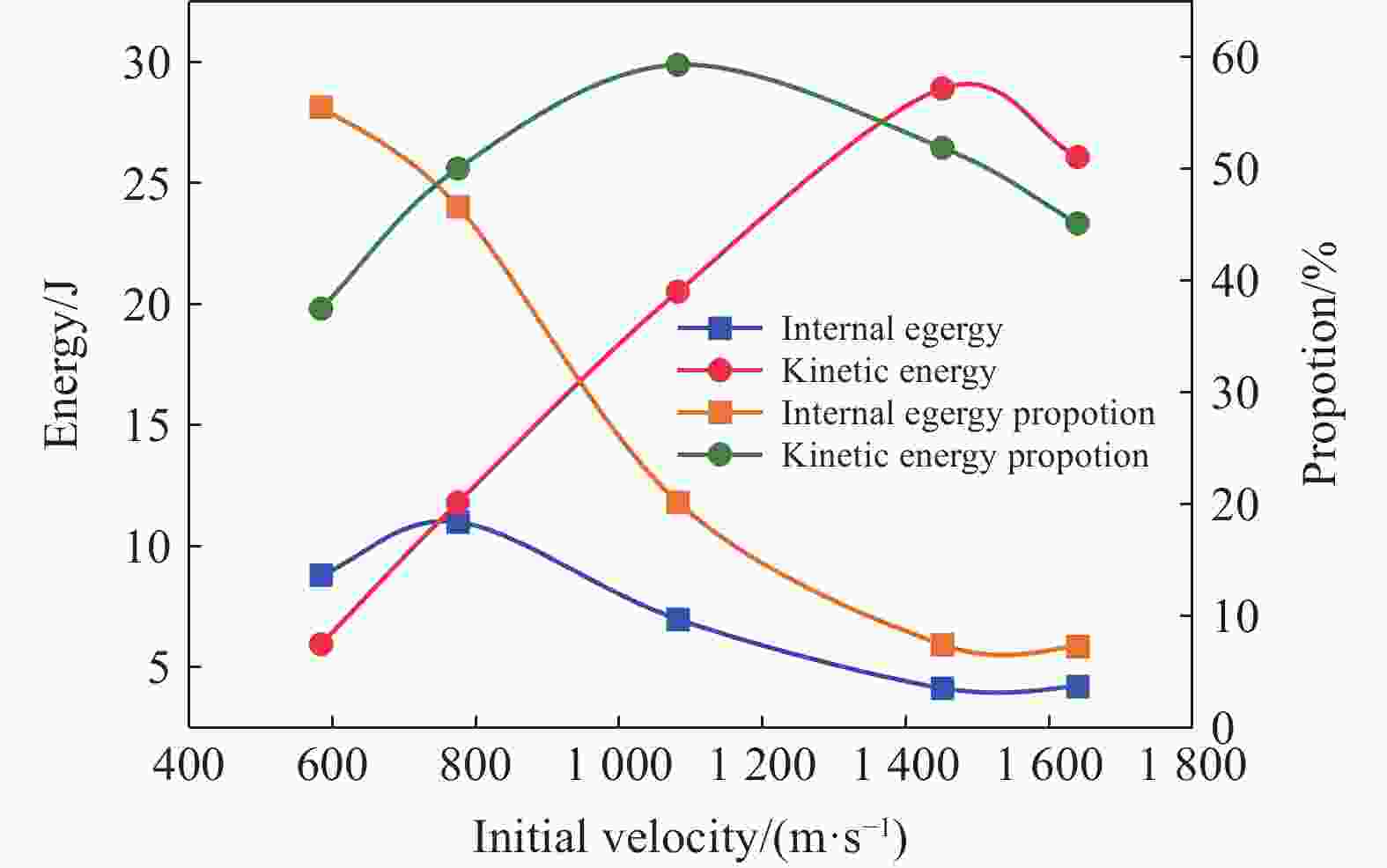A study of anti-penetration properties of continuous fiber-reinforced high-porosity composites
-
摘要: 为开展连续纤维增强高孔隙复合材料的侵彻防护性能,首先,用二级轻气炮发射Q235钢质弹丸,对连续纤维增强高孔隙复合材料开展弹道侵彻实验,计算了弹道极限,归纳和分析了其损伤的形态和模式,并将这种复合材料的侵彻防护性能与其他材料进行了比较;然后,对弹道侵彻连续纤维增强高孔隙复合材料进行了数值模拟,比较了剩余速度、损伤的形态和范围,模拟结果与实验结果吻合较好;进而通过观察有限元模拟的弹孔形态、应力分布和损伤分布等方式,对侵彻过程的损伤机理进行了分析。研究结果可为复合材料在防热、冲击防护与承受外载荷等多功能一体化的应用提供参考依据。
-
关键词:
- 连续纤维增强复合材料 /
- 弹道极限 /
- 侵彻防护性能 /
- 损伤机理 /
- 能量转化
Abstract: It is of great scientific significance and application value to study the anti-penetration performance of continuous fiber-reinforced high-porosity composites. First, the ballistic penetration experiments of 20 mm thick continuous fiber-reinforced high-porosity composites were carried out by using two-stage light gas gun firing Q235 steel projectiles of diameter 4.5 mm. Based on the analysis of the initial and final velocities of bullet penetration, the ballistic limit of the material is obtained. By observing the damage patterns of the target plate, these patterns are divided into three types from low to high according to the initial velocity of the projectiles: back-crack type, back-burst type and penetrated type. The anti-penetration performance of this composite material is compared with other materials by specific energy absorption, showing that the anti-penetration performance of the composite against low-speed penetration up to 600 m/s is better than those of steel, aluminum, Kevlar and glass fiber composite. Then, an orthogonal anisotropic continuum damage constitutive model is proposed for the continuous fiber-reinforced high-porosity composites. This constitutive model is written as a subroutine and embedded in the finite element software by secondary development. On this basis, the finite element simulations of ballistic penetrations of continuous fiber reinforced high-porosity composites are conducted. The validity of the constitutive and finite element models is verified by comparing the final velocity, ballistic limit and damage range of the back surface obtained from experiment and simulation. Furthermore, the damage mechanism of the penetration process is analyzed by observing the shape of the bullet hole, stress distribution and damage distribution obtained from the finite element simulation. The results show that the formation of the bullet hole during the penetration of spherical projectile is caused by shear damage, the debonding of fiber and matrix is caused by the combined action of compression and shear, the delamination damage of the target plate is caused by the tension wave created by the reflection of compression wave, and the fiber breakage belongs to tension damage. Besides, the kinetic energy, internal energy and their proportion to the kinetic energy change of the bullet are compared with the initial velocity. It is pointed out that most of the kinetic energy of the projectile is transformed into the kinetic energy of the fragment of target plates and the plastic deformation energy of the projectile. The research results provide a reference for the multifunctional integration of these composite materials in heat protection, penetration protection and load bearing. -
表 1 侵彻实验结果
Table 1. Experimental results of penetration
实验 初速度/(m∙s−1) 末速度/(m∙s−1) 弹丸动能/J 损伤类型 1 1640.0 1227.5 218.83 切孔型 2 1450.9 1040.1 189.31 切孔型 3 1082.0 715.5 121.87 背面炸裂型 4 1046.2 651.0 124.09 背面炸裂型 5 583.7 未穿透 63.03 未穿透 6 775.0 263.5 98.27 背面裂缝型 表 2 靶板迎弹面、背弹面损伤范围
Table 2. Damage range of the impact surface and back surface of the target plate
实验 初速度/(m∙s−1) 迎弹面损伤范围
直径/mm背弹面损伤范围
直径/mm1 1640.0 6.17 14.80 2 1450.9 8.63 14.78 3 1082.0 6.19 18.83 4 1046.2 5.19 16.07 5 583.7 5.23 未穿透 6 775.0 5.52 17.37 表 3 不同初速度下的比吸能
Table 3. Specific absorption energy under different initial velocities
实验 初速度/
(m∙s−1)末速度/
(m∙s−1)弹丸动能
变化/J比吸能/
(MJ∙kg−1)1 1640.0 1227.5 221.52 0.76 2 1450.9 1040.1 191.64 0.66 3 1082.0 715.5 123.37 0.43 4 1045.8 651.0 125.45 0.43 5 583.7 未穿透 63.81 0.37 6 775.0 263.5 99.48 0.34 表 4 靶板的材料参数
Table 4. Material parameters of the target plate
ρ/(g·cm−3) E1/GPa E2/GPa E3/GPa ν21 ν31 ν32 G12/GPa G23/GPa G13/GPa Xt/MPa 0.911 4.00 4.00 1.54 0.19 0.25 0.25 3.50 1.60 1.60 30.0 Yt/MPa Xc/MPa Yc/MPa Zt/MPa Zc/MPa S12/MPa S23/MPa S13/MPa mi Crate $ {\dot{\varepsilon }}_{0} $/s−1 30.0 89.7 89.7 10.0 78.0 20.0 15.0 15.0 1.0~3.0 0.03~0.2 10.0 材料密度/(kg·cm−3) 弹性模量/GPa 泊松比 屈服极限/MPa 切线模量/GPa 硬化参数β 参考应变率/s−1 Cowper-Symonds参数n 7850 210 0.3 235 8 1 40.4 5 表 6 数值模拟结果与实验结果的对比
Table 6. Comparison of numerical simulation results with experimental results
实验 实验初速度/(m·s−1) 实验末速度/(m·s−1) 模拟末速度/(m·s−1) 模拟与实验结果的偏差/% 1 1640.0 1227.5 1202.0 2.04 2 1450.9 1040.1 995.0 4.34 3 1082.0 715.5 697.0 2.52 4 1046.0 651.0 624.0 4.59 5 583.7 未穿透,弹孔深约12 mm 未穿透,弹孔深约13 mm 8.30 6 775.0 263.5 280.0 7.22 -
[1] 胡宁, 赵丽滨. 航空航天复合材料力学 [M]. 北京: 科学出版社, 2021: 4–5.HU N, ZHAO L B. Mechanics of aerospace composite materials [M]. Beijing: Science Press, 2021: 4–5. [2] 孙卫兵. 纤维增强复合材料层合板抗高速破片侵彻性能研究 [D]. 武汉: 武汉理工大学, 2020: 1–3. DOI: 10.27381/d.cnki.gwlgu.2020.001335.SUN W B. Research on penetration resistance of fiber reinforced composite laminates under high-speed fragments [D]. Wuhan: Wuhan University of Technology, 2020: 1–3. DOI: 10.27381/d.cnki.gwlgu.2020.001335. [3] 张昊, 孙宏杰, 孙建波, 等. 复合材料风扇机匣包容性相关研究进展 [J]. 复合材料科学与工程, 2022(7): 115–120. DOI: 10.19936/j.cnki.2096-8000.20220728.019.ZHANG H, SUN H J, SUN J B, et al. Research progress on the tolerance of composite containment fan case [J]. Composites Science and Engineering, 2022(7): 115–120. DOI: 10.19936/j.cnki.2096-8000.20220728.019. [4] 马东方, 马伯翰, 张幸锵. 冲击荷载下植物纤维增强高聚物复合材料的力学性能 [J]. 高压物理学报, 2019, 33(2): 024204. DOI: 10.11858/gywlxb.20180656.MA D F, MA B H, ZHANG X Q. Mechanical properties of natural fiber reinforced polymer composites under impact loading [J]. Chinese Journal of High Pressure Physics, 2019, 33(2): 024204. DOI: 10.11858/gywlxb.20180656. [5] JENQ S T, JING H S, CHUNG C. Predicting the ballistic limit for plain woven glass/epoxy composite laminate [J]. International Journal of Impact Engineering, 1994, 15(4): 451–464. DOI: 10.1016/0734-743X(94)80028-8. [6] JENQ S T, MO J J. Ballistic impact response for two-step braided three-dimensional textile composites [J]. AIAA Journal, 1996, 34(2): 375–384. DOI: 10.2514/3.13074. [7] LÓPEZ-PUENTE J, ZAERA R, NAVARRO C. Experimental and numerical analysis of normal and oblique ballistic impacts on thin carbon/epoxy woven laminates [J]. Composites Part A: Applied Science and Manufacturing, 2008, 39(2): 374–387. DOI: 10.1016/j.compositesa.2007.10.004. [8] 杜忠华, 赵国志, 王晓鸣, 等. 复合材料层合板抗弹性的工程分析模型 [J]. 兵器材料科学与工程, 2002, 25(1): 8–10, 60. DOI: 10.3969/j.issn.1004-244X.2002.01.002.DU Z H, ZHAO G Z, WANG X M, et al. Engineering analysis model of bullet-proof property of composite laminates [J]. Ordnance Material Science and Engineering, 2002, 25(1): 8–10, 60. DOI: 10.3969/j.issn.1004-244X.2002.01.002. [9] 王元博. 纤维增强层合材料的抗弹性能和破坏机理研究 [D]. 合肥: 中国科学技术大学, 2006: 63–67.WANG Y B. Research on ballistics resistance and failure mechanism of fiber-reinforced laminate [D]. Hefei: University of Science and Technology of China, 2006: 63–67. [10] 江琦. 改性PS/UHMWPE纤维复合材料制备及侵彻性能研究 [D]. 武汉: 武汉理工大学, 2017: 39–40.JIANG Q. Preparation and penetration properties of modified polystyrene/UHMWPE fiber composites [D]. Wuhan: Wuhan University of Technology, 2017: 39–40. [11] 谭焕成, 许善迎, 黄雄, 等. 三维四向编织复合材料宏观有限元模型冲击损伤仿真及试验验证 [J]. 复合材料学报, 2018, 35(5): 1139–1148. DOI: 10.13801/j.cnki.fhclxb.20170821.002.TAN H C, XU S Y, HUANG X, et al. Macro-scale finite element model for impact damage simulation and experimental verification of three-dimensional four-directional braided composites [J]. Acta Materiae Compositae Sinica, 2018, 35(5): 1139–1148. DOI: 10.13801/j.cnki.fhclxb.20170821.002. [12] 王云聪, 何煌, 曾首义. Kevlar纤维层合板抗弹性能的数值模拟 [J]. 四川兵工学报, 2011, 32(3): 17–20. DOI: 10.3969/j.issn.1006-0707.2011.03.006.WANG Y C, HE H, ZENG S Y. Numerical simulation of anti-resilience for Kevlar fiber laminate [J]. Journal of Ordnance Equipment Engineering, 2011, 32(3): 17–20. DOI: 10.3969/j.issn.1006-0707.2011.03.006. [13] JAGTAP K R, GHORPADE S Y, LAL A, et al. Finite element simulation of low velocity impact damage in composite laminates [J]. Materials Today: Proceedings, 2017, 4(2): 2464–2469. DOI: 10.1016/j.matpr.2017.02.098. [14] 冯志海, 师建军, 孔磊, 等. 航天飞行器热防护系统低密度烧蚀防热材料研究进展 [J]. 材料工程, 2020, 48(8): 14–24. DOI: 10.11868/j.issn.1001-4381.2020.000206.FENG Z H, SHI J J, KONG L, et al. Research progress in low-density ablative materials for thermal protection system of aerospace flight vehicles [J]. Journal of Materials Engineering, 2020, 48(8): 14–24. DOI: 10.11868/j.issn.1001-4381.2020.000206. [15] 杜明俊. 柔性复合材料结构超高速撞击防护性能研究 [D]. 哈尔滨: 哈尔滨工业大学, 2016: 15–17.DU M J. Study on hypervelocity impact on flexible composite materials [D]. Harbin: Harbin Institute of Technology, 2016: 15–17. [16] 陈战辉. 碳纤维平纹织物层合板高速冲击损伤研究 [D]. 西安: 西北工业大学, 2019: 20–23. DOI: 10.27406/d.cnki.gxbgu.2019.000202.CHEN Z H. Investigation on damage in carbon woven composite laminates caused by high velocity impact [D]. Xi’an: Northwestern Polytechnical University, 2019: 20–23. DOI: 10.27406/d.cnki.gxbgu.2019.000202. [17] LAMBERT J P, JONAS G H. Towards standardization in terminal ballistics testing: velocity representation: BRL report No. 182 [R]. Fort Belvoir: Defense Technical Information Center, 1976. [18] LEE J H, LOYA P E, LOU J, et al. Dynamic mechanical behavior of multilayer graphene via supersonic projectile penetration [J]. Science, 2014, 346(6213): 1092–1096. DOI: 10.1126/science.1258544. [19] HYON J, GONZALES M, STREIT J K, et al. Projectile impact shock-induced deformation of one-component polymer nanocomposite thin films [J]. ACS Nano, 2021, 15(2): 2439–2446. DOI: 10.1021/acsnano.0c06146. [20] DENG Y F, ZHANG W, CAO Z S. Experimental investigation on the ballistic resistance of monolithic and multi-layered plates against hemispherical-nosed projectiles impact [J]. Materials & Design, 2012, 41: 266–281. DOI: 10.1016/j.matdes.2012.05.021. [21] DENG Y F, ZHANG W, YANG Y G, et al. The ballistic performance of metal plates subjected to impact by projectiles of different strength [J]. Materials & Design, 2014, 58: 305–315. DOI: 10.1016/j.matdes.2013.12.073. [22] DEAN J, DUNLEAVY C S, BROWN P M, et al. Energy absorption during projectile perforation of thin steel plates and the kinetic energy of ejected fragments [J]. International Journal of Impact Engineering, 2009, 36(10/11): 1250–1258. DOI: 10.1016/j.ijimpeng.2009.05.002. [23] 沈玲燕. 三维正交机织玻璃纤维复合材料动态性能和抗侵彻规律研究 [D]. 合肥: 中国科学技术大学, 2013: 43–44.SHEN L Y. Research on dynamic and penetration properties of the three-dimensional orthogonal woven glass fiber composites [D]. Hefei: University of Science and Technology of China, 2013: 43–44. [24] HONG D, LI W B, ZHENG Y, et al. Experimental research on tungsten alloy spherical fragments penetrating into carbon fiber target plate [J]. Latin American Journal of Solids and Structures, 2021, 18(5): e384. DOI: 10.1590/1679-78256510. [25] 李硕, 王志军, 田非, 等. 芳纶复合材料抗破片模拟弹丸侵彻的一种工程分析方法 [J]. 弹箭与制导学报, 2014, 34(5): 98–101. DOI: 10.15892/j.cnki.djzdxb.2014.05.025.LI S, WANG Z J, TIAN F, et al. Engineering analysis on aramid composite penetration performance by fragment simulating projectile [J]. Journal of Projectiles, Rockets, Missiles and Guidance, 2014, 34(5): 98–101. DOI: 10.15892/j.cnki.djzdxb.2014.05.025. [26] ZHIKHAREV M V, SAPOZHNIKOV S B. Two-scale modeling of high-velocity fragment GFRP penetration for assessment of ballistic limit [J]. International Journal of Impact Engineering, 2017, 101: 42–48. DOI: 10.1016/j.ijimpeng.2016.08.005. [27] 黄显晴. 考虑应变率效应的玄武岩纤维复合材料低速冲击性能分析 [D]. 长春: 吉林大学, 2021: 33–35. DOI: 10.27162/d.cnki.gjlin.2021.001772.HUANG X Q. Analysis of low velocity impact properties of basalt fiber composites considering strain rate effect [D]. Changchun: Jilin University, 2021: 33–35. DOI: 10.27162/d.cnki.gjlin.2021.001772. [28] 朱艳荣. 纤维增强复合材料应变率效应的数值仿真研究 [D]. 长春: 吉林大学, 2019: 11–14.ZHU Y R. Numerical simulation of strain rate effect with fiber reinforced composite [D]. Changchun: Jilin University, 2019: 11–14. [29] 辛士红. 纤维增强树脂基复合材料层合板抗侵彻性能数值模拟研究 [D]. 合肥: 中国科学技术大学, 2015: 17–21.XIN S H. Numerical study on the penetration resistance of fiber-reinforced plastic laminates [D]. Hefei: University of Science and Technology of China, 2015: 17–21. [30] 刘万雷, 常新龙, 张晓军, 等. 基于改进Hashin准则的复合材料低速冲击损伤研究 [J]. 振动与冲击, 2016, 35(12): 209–214. DOI: 10.13465/j.cnki.jvs.2016.12.033.LIU W L, CHANG X L, ZHANG X J, et al. Low-velocity impact analysis of composite plates based on modified Hashin criterion [J]. Journal of Vibration and Shock, 2016, 35(12): 209–214. DOI: 10.13465/j.cnki.jvs.2016.12.033. [31] 张元豪, 陈长海, 朱锡. Q235钢板对高速弹的抗侵彻特性研究 [J]. 舰船科学技术, 2017, 39(2): 52–54. DOI: 10.3404/j.issn.1672-7619.2017.02.010.ZHANG Y H, CHEN C H, ZHU X. Ballistic performance of Q235 steel plate subjected to impact by middle and high velocity projectiles [J]. Ship Science and Technology, 2017, 39(2): 52–54. DOI: 10.3404/j.issn.1672-7619.2017.02.010. [32] 吴小峰, 李戈操. 某型拖车副车架的塑性变形分析及优化设计 [J]. 河北农机, 2019(12): 91–92. DOI: 10.15989/j.cnki.hbnjzzs.2019.12.063. [33] 张明, 原梅妮, 向丰华, 等. Kevlar-129纤维复合材料抗侵彻性能数值模拟 [J]. 材料导报, 2015, 29(24): 117–121. DOI: 10.11896/j.issn.1005-023X.2015.24.027.ZHANG M, YUAN M N, XIANG F H, et al. Numerical simulation of anti-penetration performance on Kevlar-129 fiber reinforced composite materials [J]. Materials Reports, 2015, 29(24): 117–121. DOI: 10.11896/j.issn.1005-023X.2015.24.027. [34] 夏靖雯, 陈智刚, 顾敏辉, 等. 钨合金破片侵彻2024铝靶的数值模拟研究 [J]. 振动与冲击, 2023, 42(15): 156–162, 224. DOI: 10.13465/j.cnki.jvs.2023.15.019.XIA J W, CHEN Z G, GU M H, et al. Numerical simulation for tungsten alloy fragments penetrating 2024 aluminum target [J]. Journal of Vibration and Shock, 2023, 42(15): 156–162, 224. DOI: 10.13465/j.cnki.jvs.2023.15.019. [35] 刘红霞. 复合材料分层损伤的数值模拟 [D]. 西安: 西北工业大学, 2006: 38. -






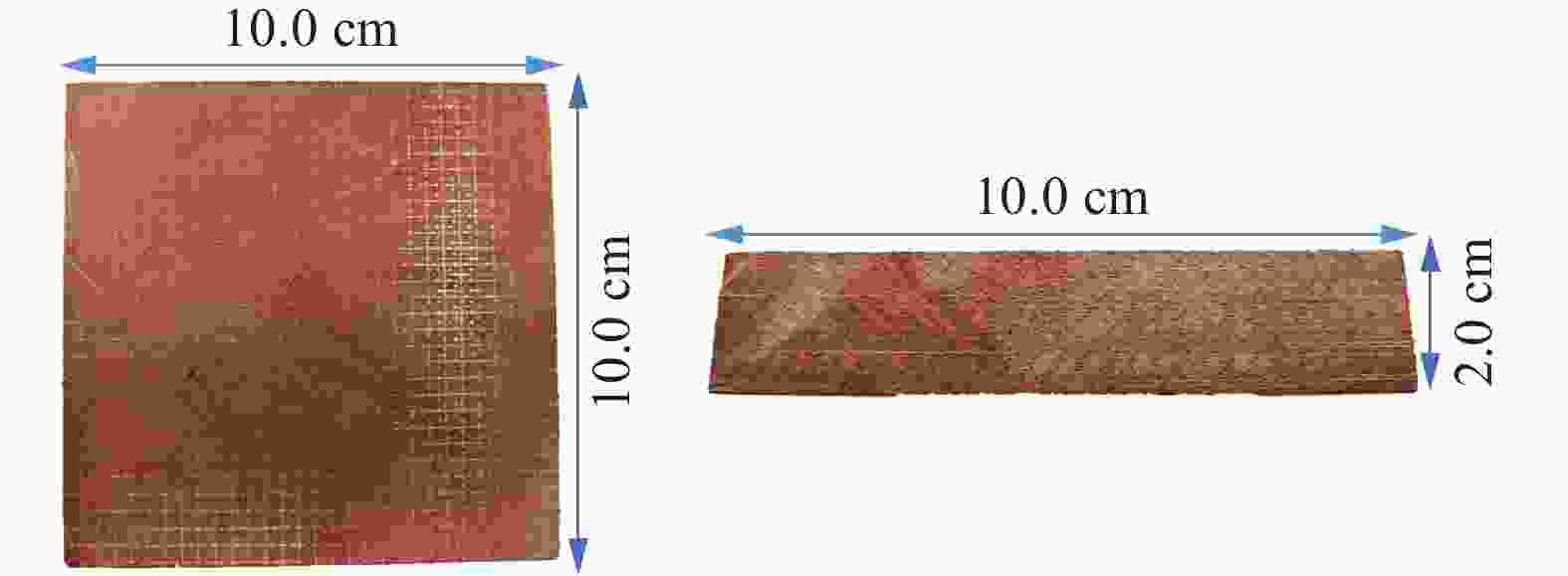
 下载:
下载:
